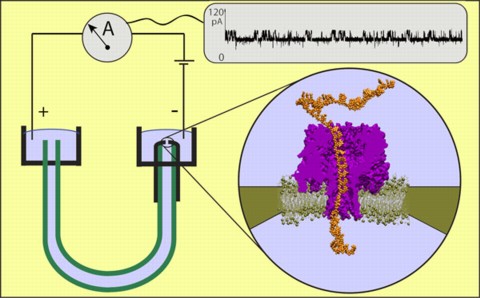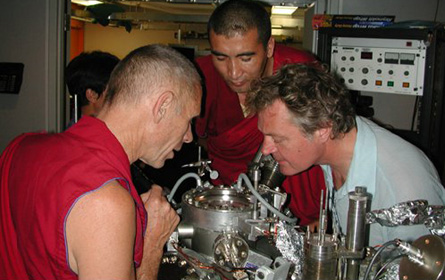Part 1 of this series of posts dealt with applications of nanotechnology for sustainable energy. Here I go on to describe why so many people are excited about the possibilities for applying nanotechnology in medicine and healthcare.
It should be no surprise that medical applications of nanotechnology are very prominent in many people’s research agenda. Despite near universal agreement about the desirablility of more medical research, though, there are some tensions in the different visions people have of future nanomedicine. To the general public the driving force is often the very personal experience most people have of illness in themselves or people close to them, and there’s a lot of public support for more work aimed at the well known killers of western world, such as cardiovascular disease, cancer, and degenerative diseases like Alzheimer’s and Parkinson’s. Economic factors, though, are important for those responsible for supplying healthcare, whether that’s the government or a private sector insurer. Maybe it’s a slight exaggeration to say that the policy makers’ ideal would be for people to live in perfect health until they were 85 and then tidily drop dead, but it’s certainly true that the prospect of an ageing population demanding more and more expensive nursing care is one that is exercising policy-makers in a number of prosperous countries. In the developing world, there are many essentially political and economic issues which stand in the way of people being able to enjoy the levels of health we take for granted in Europe and the USA, and matters like the universal provision of clean water are very important. Important though the politics of public health is, the diseases that blight developing world, such as AIDS, tuberculosis and malaria, still present major science challenges. Finally, back in the richest countries of the world, there’s a climate of higher expectations of medicine, where people look to medicine to do more than to fix obvious physical ailments, and to move into the realm of human enhancement and prolonging of life beyond what might formerly be regarded as a “natural” lifespan.
So how can nanotechnology help? There are three broad areas.
1. Therapeutic applications of nanotechnology. An important area of focus for medical applications of nanotechnology has been in the area of drug delivery. This begins from the observation that when a patient takes a conventionally delivered drug, an overwhelmingly large proportion of the administered drug molecules don’t end up acting on the biological systems that they are designed to affect. This is a serious problem if the drug has side effects; the larger the dose that has to be administered to be sure that some of the molecule actually gets to the place where it is needed, the worse these side-effects will be. This is particularly obvious, and harrowing, for the intrinsically toxic molecules the drugs used for cancer chemotherapy. Another important driving force for improving delivery mechanisms is the fact that, rather than the simple and relatively robust small molecules that have been the main active ingredients in drugs to date, we are turning increasingly to biological molecules like proteins (such as monoclonal antibodies) and nucleic acids (for example, DNA for gene therapy and small interfering RNAs). These allow very specific interventions into biological processes, but the molecules are delicate, and are easily recognised and destroyed in the body. To deliver a drug, current approaches include attaching it to a large water soluble polymer molecule which is essentially invisible to the body, or wrapping it up in a self-assembled nanoscale bag – a liposome – formed from soap like molecules like phospholipids or block copolymers. Attaching the drug to a dendrimer – a nanoscale treelike structure which may have a cavity in its centre – is conceptually midway between these two approaches. The current examples of drug delivery devices that have made it into clinical use are fairly crude, but future generations of drug delivery vehicles can be expected to include “stealth” coatings to make them less visible to the body, mechanisms for targeting them to their destination tissue or organ and mechanisms for releasing their payload when they get there. They may also incorporate systems for reporting their progress back to the outside world, even if this is only the passive device of containing some agent that shows up strongly in a medical scanner.
Another area of therapeutics in which nanotechnology can make an impact is in tissue engineering and regenerative medicine. Here it’s not so much a question of making artificial substitutes for tissues or organs; ideally it would be in providing the environment in which a patient’s own cells would develop in such a way as to generate new tissue. This is a question of persuading those cells to differentiate to take up the specialised form of a particular organ. Our cells are social organisms, which respond to chemical and physical signals as they develop and differentiate to produce tissues and organs, and the role of nanotechnology here is to provide an environment (or scaffold) which gives the cells the right physical and chemical signals. Once again, self-assembly is one way forward here, providing soft gels which can be tagged with the right chemical signals to persuade the cells to do the right thing.
2. Diagnostics. Many disease states manifest themselves by the presence of specific molecules, so the ability to detect and identify these molecules quickly and reliably, even when they are present at very low concentrations, would be very helpful for the rapid diagnosis of many different conditions. The relevance of nanotechnology is that many of the most sensitive ways of detecting molecules rely on interactions between the molecule and a specially prepared surface; the much greater importance of the surface relative to the bulk for nanostructured materials makes it possible to make sensors of great sensitivity. Sensors for the levels of relatively simple chemicals, such as glucose or thyroxine, could be integrated with devices that release the chemicals needed to rectify any imbalances (these integrated devices go by the dreadful neologism of “theranostics”); recognising pathogens by recognising stretches of DNA would give a powerful way of identifying infectious diseases without the necessity for time-consuming and expensive culturing steps. One obvious and much pursued goal would be to find a way of reading, at a single molecule level, a whole DNA sequence, making it possible cheaply to obtain an individual’s whole genome.
3. Innovation and biomedical research. A contrarian point of view, which I’ve heard frequently and forcibly expressed by a senior figure from the UK’s pharmaceutical industry, is that the emphasis in nanomedicine on drug delivery is misguided, because fundamentally what it represents is an attempt to rescue bad drug candidates. In this view the place to apply nanotechnology is the drug discovery process itself. It’s a cause for concern for the industry that it seems to be getting harder and more expensive to find new drug candidates, and the hopes that were pinned a few years ago on the use of large scale combinatorial methods don’t seem to be working out. In this view, there should be a move away from these brute force approaches to more rational methods, but this time informed by the very detailed insights into cell biology offered by the single molecule methods of bionanotechnology.



